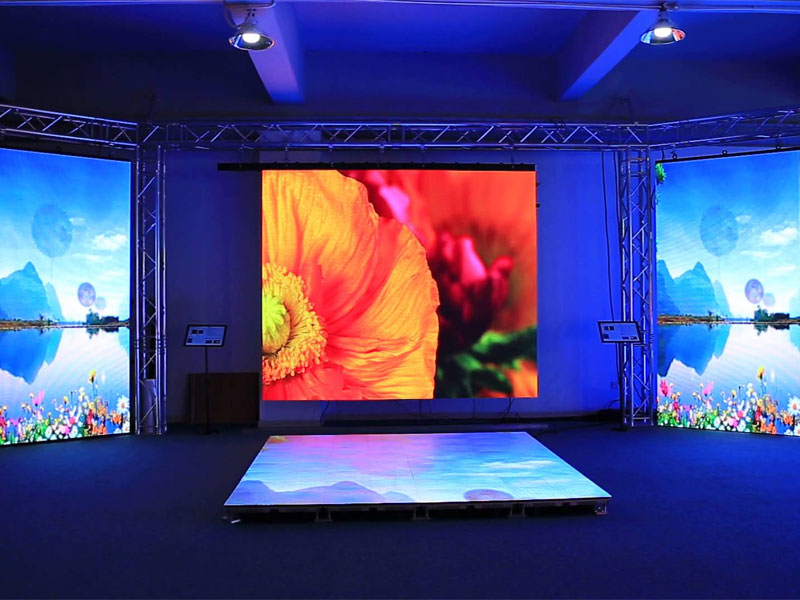
How are indoor LED screens different from outdoor ones?
An important aspect of holding a presentation, training/seminar or reporting meeting is the use of visualization tools, one of which is increasingly becoming an indoor LED screen. It allows you to use the multimedia capabilities to the maximum. At the same time, the size of LED screens can be almost any, since most of their design is composite. It is assembled from independent (self-sufficient) elements, called a cabinet or panel (an alternative, also frequently used name).
The designs of displays intended for indoors and outdoors are different, while outdoor ones can be used indoors, and “home” ones cannot be used outdoors. Let’s take a closer look.
Application of LED screens
The LED display was invented by the Americans (back in 1977), improved (made color) by the Japanese, and spread to all spheres of life (due to cost reduction) by the Chinese.
Today, products using LED screens can be found in almost any industry that requires the creation of large-size images and the transmission of information in dynamics. LED displays are widely used in advertising (both indoor and outdoor). They replace billboards and billboards; the time of static advertising (printed on posters) is inevitably becoming a thing of the past.
Thanks to the modularity of the designs, advertising surfaces can be of any size and proportion, clearly visible both day and night, and most importantly interactive. The LED screen is controlled like a regular multimedia. A billboard is now a large outdoor TV that shows the same videos as its apartment counterpart.
LED screens are very widely used in airports and train stations, and are used as various information boards (indoors and outdoors). Not a single concert or mass event can do without them.
Differences in LED screens
Differences in LED displays arise from the nature of the tasks they are designed to solve.
Firstly, differences in technical characteristics related to image transmission:
- resolution and image density;
- pixel pitch;
- brightness and contrast.
And secondly, by the place of use – outdoors or indoors.
So, an LED screen with a resolution of 1024×768 will transmit an image with the same clarity as a standard laptop screen. The size of an LED screen with such a resolution (with a pixel pitch of 10 mm) will be approximately 10.24×7.68 m. Naturally, a comfortable viewing distance for a laptop and a multi-meter LED structure will differ greatly. The density of the image (measured in the number of pixels per square meter) depends on how densely the light points (pixels) are located on the display.
The image density is directly related to the concept of pixel pitch – this is the main characteristic of an LED display, it is present in the model name. For example, the indoor LED screen model GLOSHINE S 3.91 has a pixel pitch of 3.91 mm. That is, the minimum distance between the centers of two adjacent pixels is slightly less than 4 millimeters. The larger the pitch, the higher the density and the shorter the comfortable viewing distance. There is an empirical relationship between the pitch and the distance – 1 m / mm. For the above model, the comfortable viewing distance will be approximately 4 meters (rounded up to 3.91 m).
The LED screen is brighter than the sun
Brightness greatly depends on where the device is used. For an indoor LED screen to perform its functionality well, it is enough to have luminosity indicators in the range of 800-1200 cd / m2 (or nit). A standard computer monitor shines with a strength of about 300 nits.
An outdoor tabloid must have a luminosity of up to 6000 cd/m2, only in this case, the image it produces can be seen on a bright sunny day. Because of this, outdoor structures must use powerful (and accordingly) larger LEDs. Usually, the minimum pixel pitch for outdoor LED screens is 8-10 mm.
The power consumption of outdoor LED displays is quite significant. This, along with direct costs (for consumed electricity) also increases indirect costs – due to increased requirements for power sources. The design of the screens has to include reinforced radiators (to discharge excess heat) and additional power elements to increase strength. Plus, protection from rain, wind and solar ultraviolet radiation. Working outdoors is expensive. The price of an indoor LED screen is several times lower than that of a similar size, but intended for outdoor placement. Therefore, a product intended for the street is not used in a building, although it would cope.






